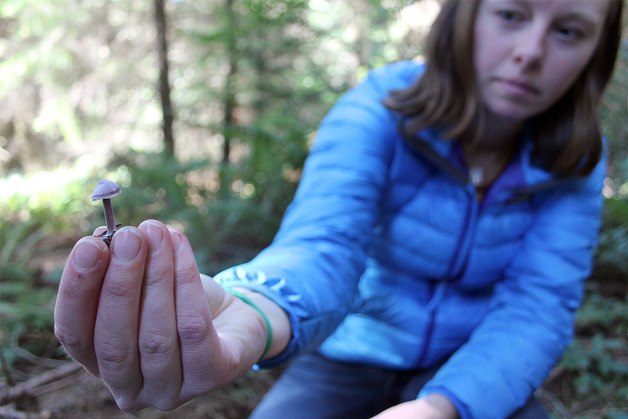Only a few steps into the Wilbert Trail at South Whidbey State Park, Ida Gianopulos is already rooting through the decaying matter of a fallen tree trying to find any sign of fungi.
About 15 seconds later and a few paces farther into the trail, she spots her first patch. It’s practically second nature for Whidbey Camano Land Trust’s conservation associate who trekked forests as a family pastime. 
“I’ve been hunting for mushrooms since I was a little kid,” she said, stooping down to gently brush away decaying leaves to expose more tiny caps and stems, solitary micro towers springing forth from the forest floor. Underneath the dark brown leaves is the white mycelium, the bulk of the actual fungus.
Her passion led her to start the fungi walk and talk tour with the land trust three years ago, and it’s grown in popularity every year as have other fungus-related activities. Gianopulos, who has a bachelor’s degree in ecology and is a hobby mycologist (someone who studies fungi), is often less interested with identifying each and every mushroom than she is obsessed with understanding how it works with its environment. Her question, she said, is typically asking what are the fungi contributing to the ecosystem.
She does not claim to be an identification expert, and so declines to name the first cluster she sees.
“I always recommend a good guide book,” she said.
That kind of curiosity has led many others on Whidbey Island, around Washington and across the country into the woods and wild places to search for mushrooms. People who do it regularly are dubbed mushroom hunters. 
Daniel Winkler, a German native who lives in Washington, is one such hunter and an author who will be in Langley at 6:30 p.m. Tuesday, Oct. 6 for a presentation about finding fungi around the Pacific Northwest. He will be at the Coupeville Library at 1:30 p.m. that day, and at the Oak Harbor Library at 2 p.m. Wednesday, Oct. 7. Winkler will also offer his expertise at the Puget Sound Mycological Society Wild Mushroom Show on Oct. 10-11 in Bellevue.
He wrote “Field Guides to Edible Mushrooms in the Pacific Northwest and California” in 2011 and maintains an active website at mushroaming.com, with a Pacific Northwest section that describes 24 varieties accompanied by photos. A professional mycology author, educator and presenter for a decade, his tips for novice mushroom foragers are simple.
“It’s good to know your trees, and persistence — you’ve got to keep looking,” he said in a phone interview Thursday.
A common refrain among mushroom hunters is to be 100 percent positive that the mushroom is safe to eat before consumption. On Winkler’s site, it’s one of the first statements on the page. “A virtual misidentification can have real consequences… ,” he warns on the site.
“When in doubt, throw it out,” he said. 
Fungi fever is even involving man’s best friend on South Whidbey. The South Whidbey Parks & Recreation District offered a popular truffle hunting program with Georgia Edwards of K9 Nosework. Carrie Monforte, program coordinator with the parks district, said there are truffles around Whidbey Island — a fact confirmed by Winkler — that are jealously guarded.
“Truffles have been found here on Whidbey,” she said in an email. “But don’t bother to ask where, no one’s going to tell you, because they are quite a prize, and if hunted with abandon, will wreck the supply and damage the area.”
Gianopulos’ hope is that people are equally concerned with conservation and an edible bounty. She will lead a pair of tours, which were fully booked within a day of their registration opening, through the forest at Whidbey Institute in Clinton next weekend. Both the morning and afternoon tour boast 20 people, plus a dozen names on the waiting list. 
Considering that the tours have filled so quickly, within hours of opening registration the past three years, she and the land trust are considering expanding the program next year.
“It’s been a good way to connect with new parts of the community,” said Janelle Blakely, communications and outreach coordinator for the land trust.
While other forms of public engagement in wild harvests have not done well for the environment, like exotic varieties of orchids or hardwoods or animals, the Whidbey Camano Land Trust maintains that mushroom harvests are plenty sustainable if done well.
“Be respectful,” Gianopulos said, adding that people should not dig around the soil of a mushroom, should always return any vegetation such as matted or decaying leaves to where it was found, and to leave the mycelium intact.
Fall is prime time for mushroom hunting. The temperature cools, rain falls and many varieties begin to push forth what’s considered the fruit of a fungus, the tasty stem and cap of delicacies such as chanterelles and oyster mushrooms. Winkler said the season will last until a “true frost” sets in closer to November, when temperatures drop to below 30 degrees.
Around Whidbey Island, Gianopulos said three common edible types include the chanterelle, shaggy mane and shaggy parasol. Chanterelles are revered for their fruity smell, like that of dried apricot, she said. Shaggy manes are mostly odorless but are pleasant tasting as long as the blackened areas are removed due to the bitter taste. Shaggy parasols are considered by Winkler to have a “strong, gamy taste,” with a recommendation to fry them with butter until light brown, then put on toast with herb butter and a thin slice of Parmesan. Winkler also noted that American Matsutakes do well around Whidbey Island near hemlocks and in sandy soil.


